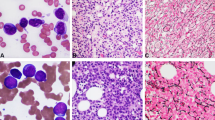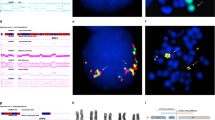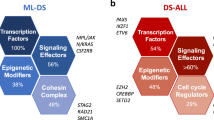Abstract
Amplification or duplication of the AML1 gene at chromosome band 21q22 was detected by FISH using a locus-specific probe in three out of 171 unselected patients with therapy-related myelodysplasia (t-MDS) or t-AML (1.7%). In two patients AML1 signals were located tandemly on derivative chromosomes, in one patient on a dic(9;21) and in the the other patient on a derivative chromosome 18 made up of interchanging layers of material from chromosomes 9, 14, 18, and 21. In the third patient three single supernumerary copies of AML1 were located on derivatives of chromosomes 19 and 21. All three patients were older, had previously received therapy with alkylating agents without topoisomerase II inhibitors, had complex karyotypes including abnormalities of chromosomes 5 or 7, and presented acquired point mutations of the TP53 gene. No point mutations of the AML1 gene were observed. The results support a pivotal role of impaired TP53 function in the development of gene amplification or duplication in t-MDS and t-AML.
This is a preview of subscription content, access via your institution
Access options
Subscribe to this journal
Receive 12 print issues and online access
$259.00 per year
only $21.58 per issue
Buy this article
- Purchase on Springer Link
- Instant access to full article PDF
Prices may be subject to local taxes which are calculated during checkout

Similar content being viewed by others
References
Tanaka T, Tanaka K, Ogawa S, Kurokawa M, Mitani K, Nishida J et al. An acute myeloid leukaemia gene, AML1, regulates hemopoietic myeloid cell differentiation and transcriptional activation antagonistically by two alternative spliced forms. EMBO J 1995; 14: 341–350.
Okuda T, Cai Z, Yang S, Lenny N, Lyu CJ, van Deursen JM et al. Expression of a knocked-in AML1-ETO leukemia gene inhibits the establishment of normal definitive hematopoiesis and directly generates dysplastic hematopoietic progenitors. Blood 1998; 91: 3134–3143.
Rhoades KL, Hetherington CJ, Harakawa N, Yergeau DA, Zhou L, Liu LQ et al. Analysis of the role of AML1-ETO in leukemogenesis, using an inducible transgenic mouse model. Blood 2000; 96: 2108–2115.
Osato M, Asou N, Abdalla E, Hoshino K, Yamasaki H, Okubo T et al. Biallelic and heterozygous point mutations in the runt domain of the AML1/PEBP2alphaB gene associated with myeloblastic leukemias. Blood 1999; 93: 1817–1824.
Christiansen DH, Andersen MK, Pedersen-Bjergaard J . Mutations of AML1 are common in therapy-related myelodysplasia following therapy with alkylating agents and are significantly associated with deletion or loss of chromosome arm 7q and with subsequent leukemic transformation. Blood 2004; 104: 1474–1481.
Niini T, Kanerva J, Vettenranta K, Saarinen-Pihkala UM, Knuutila S . AML1 gene amplification: a novel finding in childhood acute lymphoblastic leukemia. Haematologica 2000; 85: 362–366.
Dal Cin P, Atkins L, Ford C, Ariyanayagam S, Armstrong SA, George R et al. Amplification of AML1 in childhood acute lymphoblastic leukemias. Genes Chromosomes Cancer 2001; 30: 407–409.
Robinson HM, Broadfield ZJ, Cheung KL, Harewood L, Harris RL, Jalali GR et al. Amplification of AML1 in acute lymphoblastic leukemia is associated with a poor outcome. Leukemia 2003; 17: 2249–2250.
Harewood L, Robinson H, Harris R, Al-Obaidi MJ, Jalali GR, Martineau M et al. Amplification of AML1 on a duplicated chromosome 21 in acute lymphoblastic leukemia: a study of 20 cases. Leukemia 2003; 17: 547–553.
Kakazu N, Taniwaki M, Horiike S, Nishida K, Tatekawa T, Nagai M et al. Combined spectral karyotyping and DAPI banding analysis of chromosome abnormalities in myelodysplastic syndrome. Genes Chromosomes Cancer 1999; 26: 336–345.
Hilgenfeld E, Padilla-Nash H, McNeil N, Knutsen T, Montagna C, Tchinda J et al. Spectral karyotyping and fluorescence in situ hybridization detect novel chromosomal aberrations, a recurring involvement of chromosome 21 and amplification of the MYC oncogene in acute myeloid leukaemia M2. Br J Haematol 2001; 113: 305–317.
Streubel B, Valent P, Lechner K, Fonatsch C . Amplification of the AML1(CBFA2) gene on ring chromosomes in a patient with acute myeloid leukemia and a constitutional ring chromosome 21. Cancer Genet Cytogenet 2001; 124: 42–46.
Mrozek K, Heinonen K, Theil KS, Bloomfield CD . Spectral karyotyping in patients with acute myeloid leukemia and a complex karyotype shows hidden aberrations, including recurrent overrepresentation of 21q, 11q, and 22q. Genes Chromosomes Cancer 2002; 34: 137–153.
Roumier C, Fenaux P, Lafage M, Imbert M, Eclache V, Preudhomme C . New mechanisms of AML1 gene alteration in hematological malignancies. Leukemia 2003; 17: 9–16.
Van Limbergen H, Poppe B, Michaux L, Herens C, Brown J, Noens L et al. Identification of cytogenetic subclasses and recurring chromosomal aberrations in AML and MDS with complex karyotypes using M-FISH. Genes Chromosomes Cancer 2002; 33: 60–72.
Andersen MK, Christiansen DH, Kirchhoff M, sf Pedersen-Bjergaard J . Duplication or amplification of chromosome band 11q23, including the unrearranged MLL gene, is a recurrent abnormality in therapy-related MDS and AML, and is closely related to mutation of the TP53 gene and to previous therapy with alkylating agents. Genes Chromosomes Cancer 2001; 31: 33–41.
Pedersen-Bjergaard J, Timshel S, Andersen MK, Andersen AS, Philip P . Cytogenetically unrelated clones in therapy-related myelodysplasia and acute myeloid leukemia: experience from the Copenhagen series updated to 180 consecutive cases. Genes Chromosomes Cancer 1998; 23: 337–349.
Christiansen DH, Andersen MK, Pedersen-Bjergaard J . Mutations with loss of heterozygosity of p53 are common in therapy-related myelodysplasia and acute myeloid leukemia after exposure to alkylating agents and significantly associated with deletion or loss of 5q, a complex karyotype, and a poor prognosis. J Clin Oncol 2001; 19: 1405–1413.
Penther D, Preudhomme C, Talmant P, Roumier C, Godon A, Mechinaud F et al. Amplification of AML1 gene is present in childhood acute lymphoblastic leukemia but not in adult, and is not associated with AML1 gene mutation. Leukemia 2002; 16: 1131–1134.
Coquelle A, Pipiras E, Toledo F, Buttin G, Debatisse M . Expression of fragile sites triggers intrachromosomal mammalian gene amplification and sets boundaries to early amplicons. Cell 1997; 89: 215–225.
Livingstone LR, White A, Sprouse J, Livanos E, Jacks T, Tlsty TD . Altered cell cycle arrest and gene amplification potential accompany loss of wild-type p53. Cell 1992; 70: 923–935.
Yin Y, Tainsky MA, Bischoff FZ, Strong LC, Wahl GM . Wild-type p53 restores cell cycle control and inhibits gene amplification in cells with mutant p53 alleles. Cell 1992; 70: 937–948.
Poppe B, Vandesompele J, Schoch C, Lindvall C, Mrozek K, Bloomfield CD et al. Expression analyses identify MLL as a prominent target of 11q23 amplification and support an etiologic role for MLL gain of function in myeloid malignancies. Blood 2004; 103: 229–235.
Mikhail FM, Serry KA, Hatem N, Mourad ZI, Farawela HM, El Kaffash DM et al. AML1 gene over-expression in childhood acute lymphoblastic leukemia. Leukemia 2002; 16: 658–668.
Kurokawa M, Tanaka T, Tanaka K, Ogawa S, Mitani K, Yazaki Y et al. Overexpression of the AML1 proto-oncoprotein in NIH3T3 cells leads to neoplastic transformation depending on the DNA-binding and transactivational potencies. Oncogene 1996; 12: 883–892.
Baldus CD, Liyanarachchi S, Mrozek K, Auer H, Tanner SM, Guimond M et al. Acute myeloid leukemia with complex karyotypes and abnormal chromosome 21: amplification discloses overexpression of APP, ETS2, and ERG genes. Proc Natl Acad Sci USA 2004; 101: 3915–3920.
Acknowledgements
We are indebted to Inge-Lise Frost Andersen and to Pia Bech for excellent technical assistance in performing the FISH analyses and the mutation analyses of TP53 and AML1, respectively.
Author information
Authors and Affiliations
Corresponding author
Additional information
The study was supported by grants from the Danish Cancer society
Rights and permissions
About this article
Cite this article
Andersen, M., Christiansen, D. & Pedersen-Bjergaard, J. Amplification or duplication of chromosome band 21q22 with multiple copies of the AML1 gene and mutation of the TP53 gene in therapy-related MDS and AML. Leukemia 19, 197–200 (2005). https://doi.org/10.1038/sj.leu.2403612
Received:
Accepted:
Published:
Issue Date:
DOI: https://doi.org/10.1038/sj.leu.2403612
Keywords
This article is cited by
-
21q22 amplification detection in three patients with acute myeloid leukemia: cytogenomic profiling and literature review
Molecular Cytogenetics (2022)
-
iAMP21 in acute myeloid leukemia is associated with complex karyotype, TP53 mutation and dismal outcome
Modern Pathology (2020)
-
Fanconi Anemia patient with AML1 gene amplification and monosomy 7 in pre-transplant myelodysplasia (MDS) relapsing 7 years after successful allo-SCT
Bone Marrow Transplantation (2008)
-
Genetics of therapy-related myelodysplasia and acute myeloid leukemia
Leukemia (2008)
-
Chromosomal aberrations in congenital bone marrow failure disorders—an early indicator for leukemogenesis?
Annals of Hematology (2007)



